Bibliometrics and Visualization Analysis of Three Obligate Organohalide Respiring Bacteria Genera: A Systematic Review
Abstract
1. Introduction
2. Materials and Methods
2.1. Data Source and Retrieval
2.2. Statistical Methods
3. Results
3.1. Basic Quantitative Information
3.2. Authors and Inter-Author Cooperation
3.3. Country and Inter-Country Cooperation
3.4. Journals
3.5. Keyword Cluster Analysis and Burst Analysis
4. Discussion
- 1.
- Combined pollution remediation.
- 2.
- Inter-species microbial interactions within the microbiome.
- 3.
- Multidisciplinary technology coupling for pollution control.
- 4.
- Further in-depth studies of omics technology.
5. Conclusions
Supplementary Materials
Author Contributions
Funding
Institutional Review Board Statement
Informed Consent Statement
Data Availability Statement
Conflicts of Interest
References
- He, H.; Li, Y.; Shen, R.; Shim, H.; Zeng, Y.; Zhao, S.; Lu, Q.; Mai, B.; Wang, S. Environmental occurrence and remediation of emerging organohalides: A review. Environ. Pollut. 2021, 290, 118060. [Google Scholar] [CrossRef] [PubMed]
- Wackett, L.P. Recruitment of co-metabolic enzymes for environmental detoxification of organohalides. Environ. Health Perspect. 1995, 103, 45–48. [Google Scholar] [PubMed][Green Version]
- Liu, G.; Chen, K.; Wu, Z.; Ji, Y.; Lu, L.; Liu, S.; Li, Z.L.; Ji, R.; Liu, S.J.; Jiang, J.; et al. Genome-centric metatranscriptomic characterization of a humin-facilitated anaerobic tetrabromobisphenol a-dehalogenating consortium. Environ. Sci. Technol. 2024, 58, 1299–1311. [Google Scholar] [CrossRef] [PubMed]
- Adrian, L.; Löffler, F. Organohalide-Respiring Bacteria; Springer: Berlin/Heidelberg, Germany, 2016; Volume 1. [Google Scholar]
- Jugder, B.E.; Ertan, H.; Bohl, S.; Lee, M.; Marquis, C.P.; Manefield, M. Organohalide Respiring Bacteria and Reductive Dehalogenases: Key Tools in Organohalide Bioremediation. Front. Microbiol. 2016, 7, 249. [Google Scholar] [CrossRef] [PubMed]
- Simpson, W.R.; Brown, S.S.; Saiz-Lopez, A.; Thornton, J.A.; von Glasow, R. Tropospheric halogen chemistry: Sources, cycling, and impacts. Chem. Rev. 2015, 115, 4035–4062. [Google Scholar] [CrossRef] [PubMed]
- Maphosa, F.; de Vos, W.M.; Smidt, H. Exploiting the ecogenomics toolbox for environmental diagnostics of organohalide-respiring bacteria. Trends Biotechnol. 2010, 28, 308–316. [Google Scholar] [CrossRef] [PubMed]
- Nijenhuis, I.; Kuntze, K. Anaerobic microbial dehalogenation of organohalides-state of the art and remediation strategies. Curr. Opin. Biotechnol. 2016, 38, 33–38. [Google Scholar] [CrossRef] [PubMed]
- Seshadri, R.; Adrian, L.; Fouts, D.E.; Eisen, J.A.; Phillippy, A.M.; Methe, B.A.; Ward, N.L.; Nelson, W.C.; Deboy, R.T.; Khouri, H.M.; et al. Genome sequence of the PCE-dechlorinating bacterium Dehalococcoides ethenogenes. Science 2005, 307, 105–108. [Google Scholar] [CrossRef] [PubMed]
- Kube, M.; Beck, A.; Zinder, S.H.; Kuhl, H.; Reinhardt, R.; Adrian, L. Genome sequence of the chlorinated compound-respiring bacterium Dehalococcoides species strain CBDB1. Nat. Biotechnol. 2005, 23, 1269–1273. [Google Scholar] [CrossRef] [PubMed]
- Nonaka, H.; Keresztes, G.; Shinoda, Y.; Ikenaga, Y.; Abe, M.; Naito, K.; Inatomi, K.; Furukawa, K.; Inui, M.; Yukawa, H. Complete genome sequence of the dehalorespiring bacterium Desulfitobacterium hafniense Y51 and comparison with Dehalococcoides ethenogenes 195. J. Bacteriol. 2006, 188, 2262–2274. [Google Scholar] [CrossRef] [PubMed]
- Müller, J.A.; Rosner, B.M.; Von Abendroth, G.; Meshulam-Simon, G.; McCarty, P.L.; Spormann, A.M. Molecular identification of the catabolic vinyl chloride reductase from Dehalococcoides sp. strain VS and its environmental distribution. Appl. Environ. Microbiol. 2004, 70, 4880–4888. [Google Scholar] [CrossRef] [PubMed]
- Löffler, F.E.; Sun, Q.; Li, J.; Tiedje, J.M. 16S rRNA gene-based detection of tetrachloroethene-dechlorinating Desulfuromonas and Dehalococcoides species. Appl. Environ. Microbiol. 2000, 66, 1369–1374. [Google Scholar] [CrossRef]
- Men, Y.; Feil, H.; Verberkmoes, N.C.; Shah, M.B.; Johnson, D.R.; Lee, P.K.; West, K.A.; Zinder, S.H.; Andersen, G.L.; Alvarez-Cohen, L. Sustainable syntrophic growth of Dehalococcoides ethenogenes strain 195 with Desulfovibrio vulgaris hildenborough and Methanobacterium congolense: Global transcriptomic and proteomic analyses. ISME J. 2012, 6, 410–421. [Google Scholar] [CrossRef] [PubMed]
- Amos, B.K.; Ritalahti, K.M.; Cruz-Garcia, C.; Padilla-Crespo, E.; Löffler, F.E. Oxygen effect on Dehalococcoides viability and biomarker quantification. Environ. Sci. Technol. 2008, 2, 5718–5726. [Google Scholar] [CrossRef] [PubMed]
- Macbeth, T.W.; Cummings, D.E.; Spring, S.; Petzke, L.M.; Sorenson, K.S., Jr. Molecular characterization of a dechlorinating community resulting from in situ biostimulation in a trichloroethene-contaminated deep, fractured basalt aquifer and comparison to a derivative laboratory culture. Appl. Environ. Microbiol. 2004, 70, 7329–7341. [Google Scholar] [CrossRef] [PubMed]
- van Doesburg, W.; van Eekert, M.H.; Middeldorp, P.J.; Balk, M.; Schraa, G.; Stams, A.J. Reductive dechlorination of beta-hexachlorocyclohexane (beta-HCH) by a Dehalobacter species in coculture with a Sedimentibacter sp. FEMS Microbiol. Ecol. 2005, 54, 87–95. [Google Scholar]
- Freeborn, R.A.; West, K.A.; Bhupathiraju, V.K.; Chauhan, S.; Rahm, B.G.; Richardson, R.E.; Alvarez-Cohen, L. Phylogenetic analysis of TCE-dechlorinating consortia enriched on a variety of electron donors. Environ. Sci. Technol. 2005, 39, 8358–8368. [Google Scholar] [CrossRef] [PubMed]
- Page, M.J.; McKenzie, J.E.; Bossuyt, P.M.; Boutron, I.; Hoffmann, T.C.; Mulrow, C.D.; Shamseer, L.; Tetzlaff, J.M.; Akl, E.A.; Brennan, S.E.; et al. The PRISMA 2020 statement: An updated guideline for reporting systematic reviews. BMJ 2021, 372, n71. [Google Scholar] [CrossRef] [PubMed]
- Synnestvedt, M.B.; Chen, C.; Holmes, J.H. CiteSpace II: Visualization and knowledge discovery in bibliographic databases. AMIA Annu. Symp. Proc. 2005, 2005, 724–728. [Google Scholar] [PubMed]
- Ding, X.; Yang, Z. Knowledge mapping of platform research: A visual analysis using VOSviewer and CiteSpace. Electron. Commer. Res. 2022, 22, 787–809. [Google Scholar] [CrossRef]
- van Eck, N.J.; Waltman, L. Software survey: VOSviewer, a computer program for bibliometric mapping. Scientometrics 2010, 84, 523–538. [Google Scholar] [CrossRef] [PubMed]
- Seifert, E. OriginPro 9.1: Scientific data analysis and graphing software-software review. J. Chem. Inf. Model. 2014, 54, 1552. [Google Scholar] [CrossRef] [PubMed]
- Mittal, M.; Raheja, N.G. Data Visualization and Storytelling with Tableau; CRC Press: Boca Raton, FL, USA, 2024. [Google Scholar]
- Yang, Y.; Higgins, S.A.; Yan, J.; Şimşir, B.; Chourey, K.; Iyer, R.; Hettich, R.L.; Baldwin, B.; Ogles, D.M.; Löffler, F.E. Grape pomace compost harbors organohalide-respiring Dehalogenimonas species with novel reductive dehalogenase genes. ISME J. 2017, 11, 2767–2780. [Google Scholar] [CrossRef] [PubMed]
- Dolinová, I.; Štrojsová, M.; Černík, M.; Němeček, J.; Macháčková, J.; Ševců, A. Microbial degradation of chloroethenes: A review. Environ. Sci. Pollut. Res. Int. 2017, 24, 13262–13283. [Google Scholar] [CrossRef] [PubMed]
- Fincker, M.; Spormann, A.M. Biochemistry of catabolic reductive dehalogenation. Annu. Rev. Biochem. 2017, 86, 357–386. [Google Scholar] [CrossRef] [PubMed]
- de Solla Price, D.J. Little Science, Big Science; Columbia University Press: New York, NY, USA, 1963. [Google Scholar]
- Löffler, F.E.; Yan, J.; Ritalahti, K.M.; Adrian, L.; Edwards, E.A.; Konstantinidis, K.T.; Müller, J.A.; Fullerton, H.; Zinder, S.H.; Spormann, A.M. Dehalococcoides mccartyi gen. nov., sp. nov., obligately organohalide-respiring anaerobic bacteria relevant to halogen cycling and bioremediation, belong to a novel bacterial class, Dehalococcoidia classis nov., order Dehalococcoidales ord. nov. and family Dehalococcoidaceae fam. nov., within the phylum Chloroflexi. Int. J. Syst. Evol. Microbiol. 2013, 63, 625–635. [Google Scholar] [CrossRef] [PubMed]
- Chen, Y.; Cao, B.; Zhou, Q.; Liu, Y.; He, Q.; Zhao, M. Bibliometric evaluation of 2020-2022 publications on COVID-19-related cardiovascular disease. Front. Cardiovasc. Med. 2023, 13, 1070336. [Google Scholar] [CrossRef] [PubMed]
- He, J.; Ritalahti, K.M.; Yang, K.L.; Koenigsberg, S.S.; Löffler, F.E. Detoxification of vinyl chloride to ethene coupled to growth of an anaerobic bacterium. Nature 2003, 424, 62–65. [Google Scholar] [CrossRef] [PubMed]
- Ritalahti, K.M.; Amos, B.K.; Sung, Y.; Wu, Q.; Koenigsberg, S.S.; Löffler, F.E. Quantitative PCR targeting 16S rRNA and reductive dehalogenase genes simultaneously monitors multiple Dehalococcoides strains. Appl. Environ. Microbiol. 2006, 72, 2765–2774. [Google Scholar] [CrossRef] [PubMed]
- Lu, Q.; Zou, X.; Liu, J.; Liang, Z.; Shim, H.; Qiu, R.; Wang, S. Inhibitory effects of metal ions on reductive dechlorination of polychlorinated biphenyls and perchloroethene in distinct organohalide-respiring bacteria. Environ. Int. 2020, 135, 105373. [Google Scholar] [CrossRef] [PubMed]
- Li, Z.T.; Yang, S.Y.; Zhao, H.P. The effects of arsenic on dechlorination of trichloroethene by consortium DH: Microbial response and resistance. Sci. Total Environ. 2023, 896, 165219. [Google Scholar] [CrossRef] [PubMed]
- Li, Z.T.; Song, X.; Yuan, S.; Zhao, H.P. Unveiling the inhibitory mechanisms of chromium exposure on microbial reductive dechlorination: Kinetics and microbial responses. Water Res. 2024, 253, 121328. [Google Scholar] [CrossRef] [PubMed]
- Richardson, R.E. Genomic insights into organohalide respiration. Curr. Opin. Biotechnol. 2013, 24, 498–505. [Google Scholar] [CrossRef] [PubMed]
- Türkowsky, D.; Jehmlich, N.; Diekert, G.; Adrian, L.; von Bergen, M.; Goris, T. An integrative overview of genomic, transcriptomic and proteomic analyses in organohalide respiration research. FEMS Microbiol. Ecol. 2018, 94. [Google Scholar] [CrossRef] [PubMed]
- Wu, N.; Li, Y.; Liu, Y.; Feng, Y.; Fei, W.; Zheng, T.; Rong, L.; Luo, N.; Song, Y.; Wei, W.; et al. Reductive dechlorination of 1,1,2-trichloroethane in groundwater by zero valent iron coupled with biostimulation under sulfate stress: Differences and potential mechanisms. Environ. Res. 2025, 277, 121574. [Google Scholar] [CrossRef] [PubMed]
- Xu, G.; Wang, J.; Lu, M. Complete debromination of decabromodiphenyl ether using the integration of Dehalococcoides sp. strain CBDB1 and zero-valent iron. Chemosphere 2014, 117, 455–461. [Google Scholar] [CrossRef] [PubMed]
- Czinnerová, M.; Vološčuková, O.; Marková, K.; Ševců, A.; Černík, M.; Nosek, J. Combining nanoscale zero-valent iron with electrokinetic treatment for remediation of chlorinated ethenes and promoting biodegradation: A long-term field study. Water Res. 2020, 175, 115692. [Google Scholar] [CrossRef] [PubMed]
- Liu, J.; Xu, G.; Zhao, S.; Chen, C.; Rogers, M.J.; He, J. Mechanistic and microbial ecological insights into the impacts of micro- and nano- plastics on microbial reductive dehalogenation of organohalide pollutants. J. Hazard. Mater. 2023, 448, 130895. [Google Scholar] [CrossRef] [PubMed]
- Xu, G.; Zhao, X.; Zhao, S.; He, J. Acceleration of polychlorinated biphenyls remediation in soil via sewage sludge amendment. J. Hazard. Mater. 2021, 420, 126630. [Google Scholar] [CrossRef] [PubMed]
- Lorini, L.; Rossi, M.M.; Di Franca, M.L.; Villano, M.; Matturro, B.; Petrangeli Papini, M. A coupled adsorption-biodegradation (CAB) process employing a polyhydroxybutyrate (PHB)-biochar mini pilot-scale reactor for trichloroethylene-contaminated groundwater remediation. Bioengineering 2025, 12, 148. [Google Scholar] [CrossRef] [PubMed]

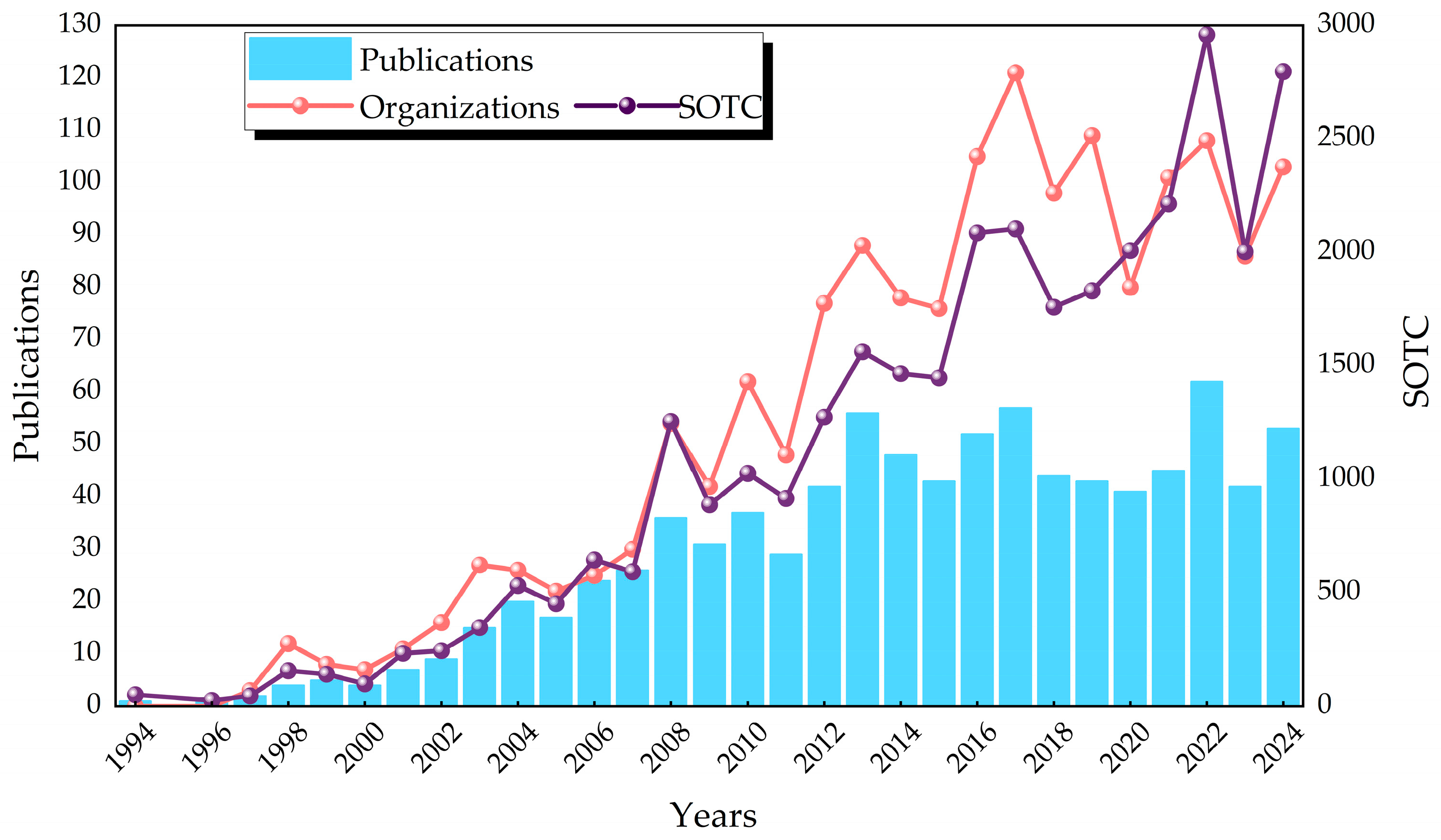
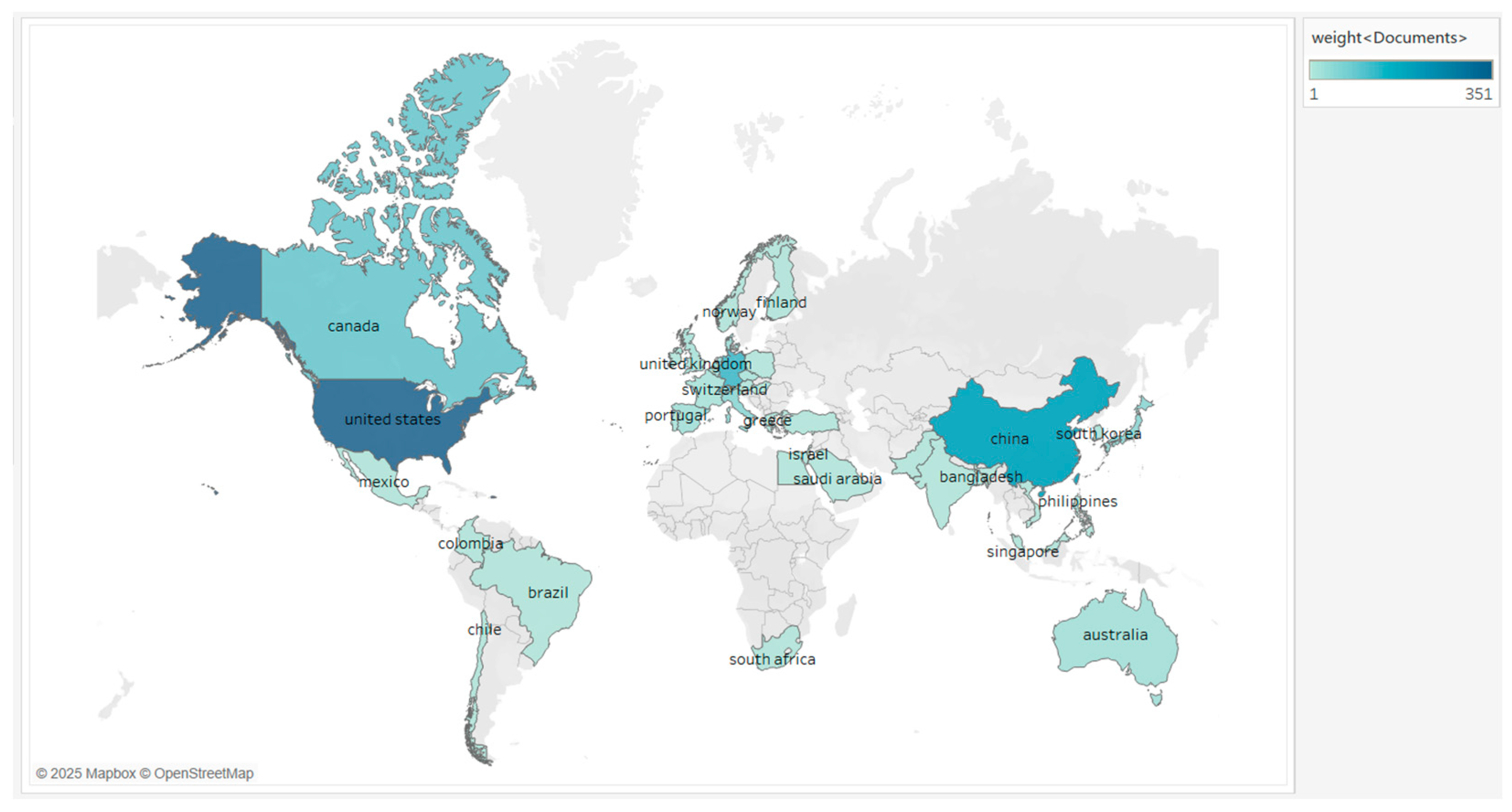

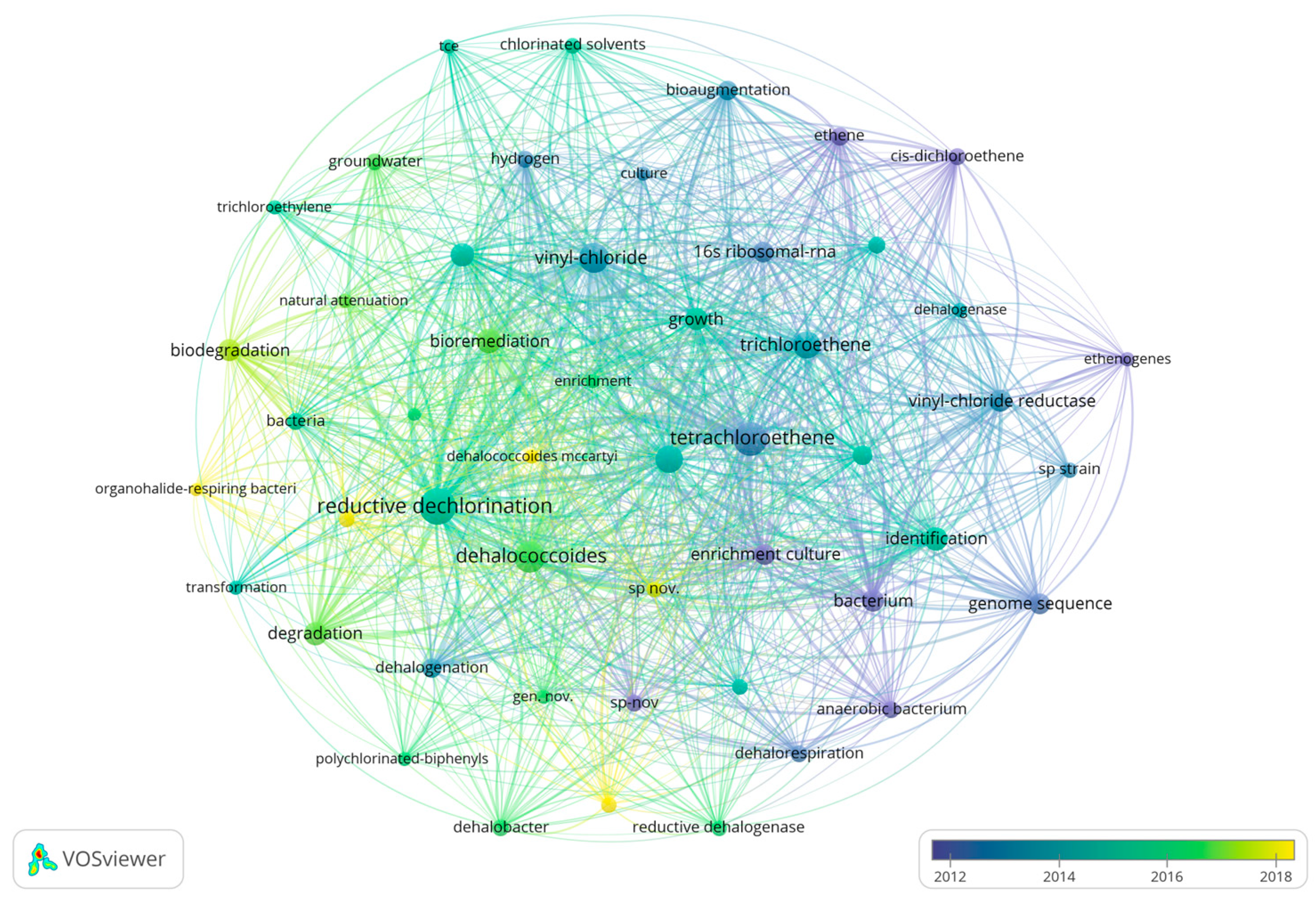
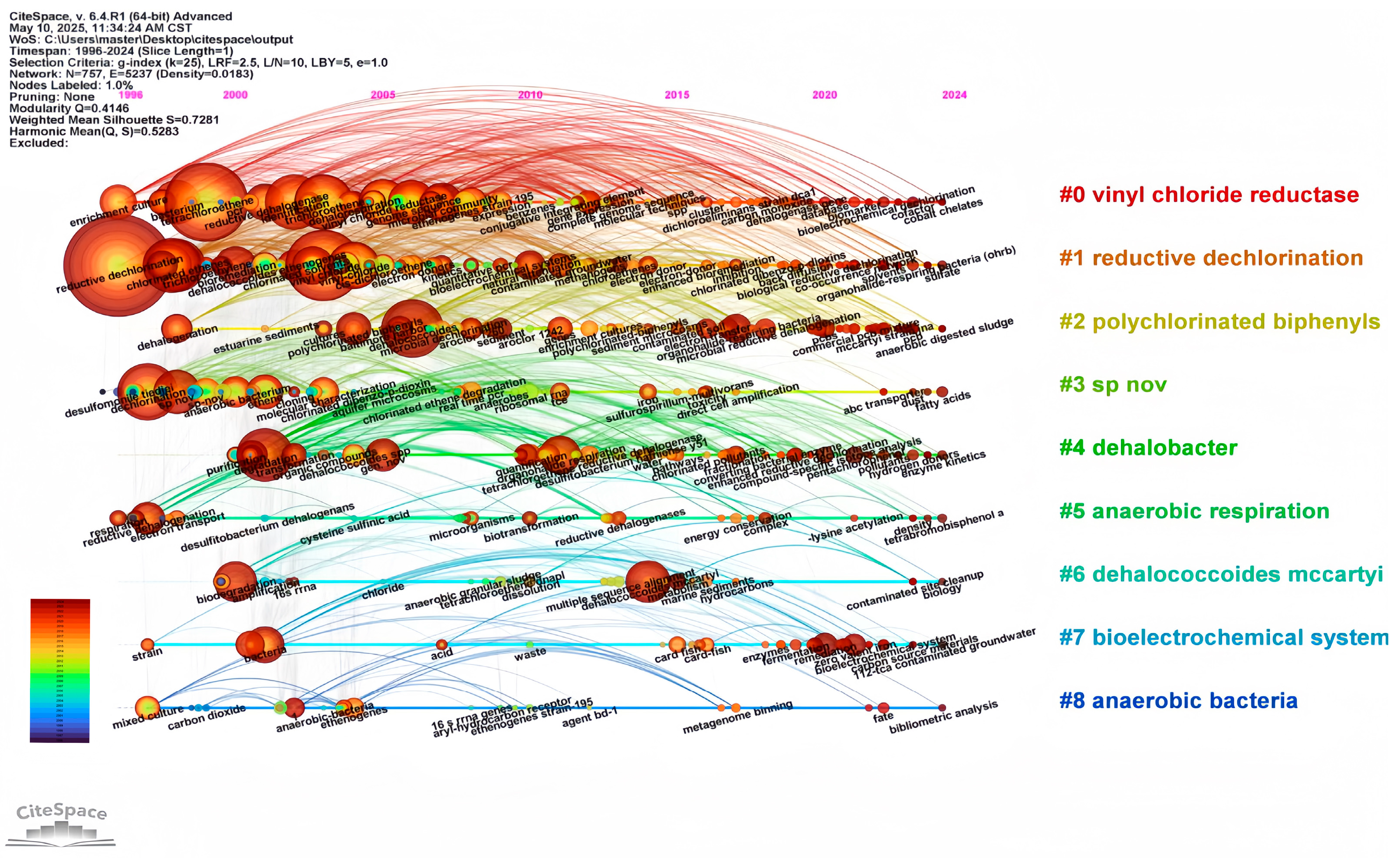

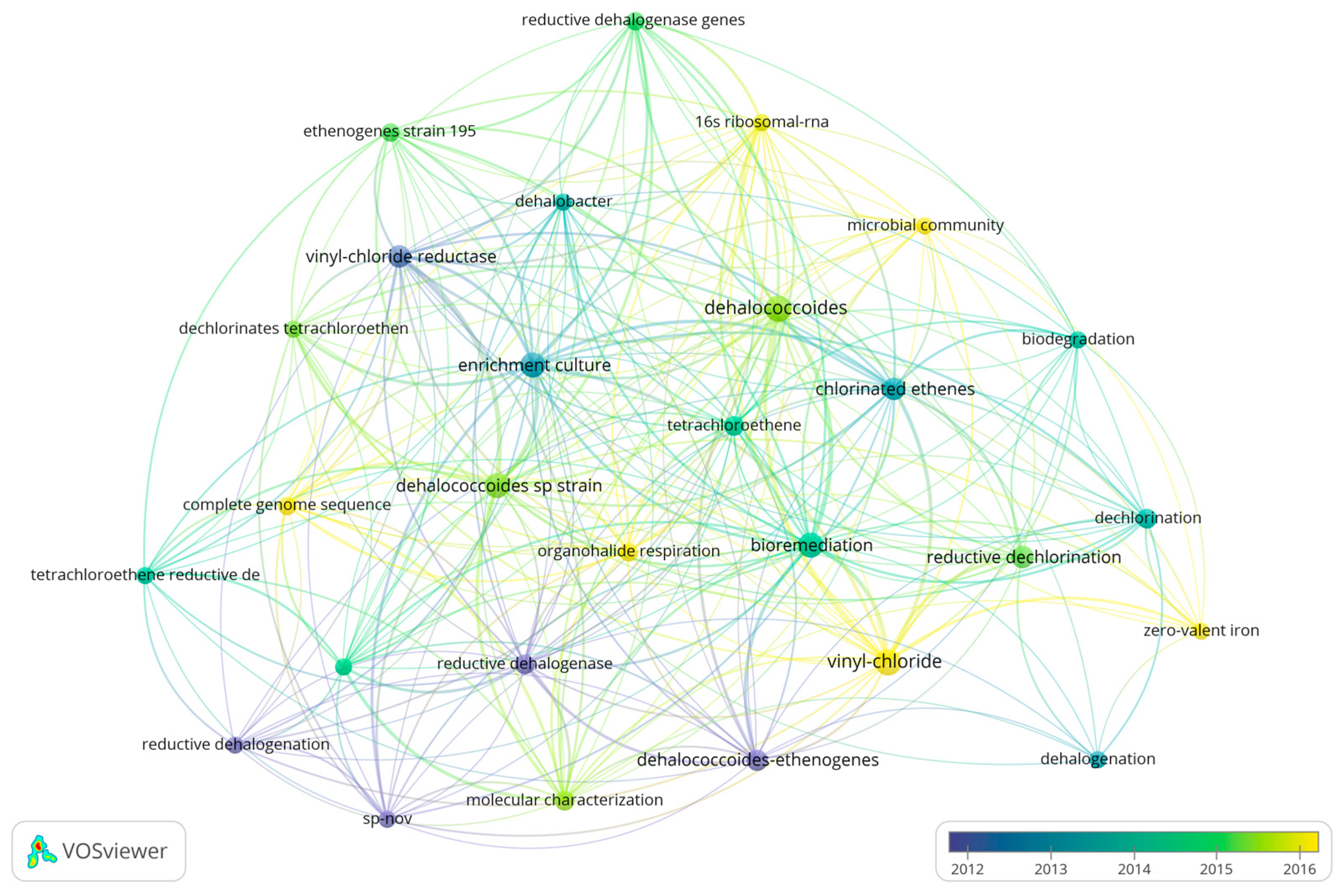
| Rank | Author | Documents | Citations | Average Citation/Publication | H-Index |
|---|---|---|---|---|---|
| 1 | Frank E. Löffler | 66 | 4980 | 75.45 | 48 |
| 2 | Lorenz Adrian | 52 | 3489 | 67.1 | 41 |
| 3 | Jianzhong He | 51 | 2151 | 42.18 | 39 |
| 4 |
Elizabeth Anne Edwards | 50 | 2745 | 54.9 | 50 |
| 5 | Lisa Alvarez-Cohen | 38 | 1975 | 51.97 | 56 |
| Rank | Country | Documents | Citations | Average Citation/ Publication |
|---|---|---|---|---|
| 1 | USA | 351 | 18,616 | 53.04 |
| 2 | China | 202 | 4103 | 20.31 |
| 3 | Germany | 135 | 6862 | 50.83 |
| 4 | Canada | 89 | 4587 | 51.54 |
| 5 | Singapore | 52 | 1831 | 35.21 |
| 6 | Italy | 52 | 1430 | 27.5 |
| 7 | Japan | 51 | 1493 | 29.27 |
| 8 | Netherlands | 44 | 2962 | 67.32 |
| 9 | Switzerland | 41 | 2121 | 51.73 |
| 10 | Denmark | 29 | 1211 | 41.76 |
| Rank | Journal Name | Documents | Citations | Average Citation/Publication | Journal Impact Factor ™(Five Year) | Category Quartile |
|---|---|---|---|---|---|---|
| 1 | Environmental Science & Technology | 160 | 6622 | 41.39 | 11.7 | Q1 |
| 2 | Applied and Environmental Microbiology | 92 | 7857 | 85.4 | 4.6 | Q2 |
| 3 | Fems Microbiology Ecology | 43 | 1251 | 29.09 | 4.2 | Q2 |
| 4 | Journal of Hazardous Materials | 38 | 817 | 21.5 | 11.9 | Q1 |
| 5 | Frontiers in Microbiology | 36 | 754 | 20.94 | 5.1 | Q2 |
| 6 | Water Research | 32 | 1318 | 41.19 | 12.2 | Q1 |
| 7 | Science of the Total Environment | 30 | 559 | 18.63 | 8.6 | Q1 |
| 8 | Chemosphere | 30 | 791 | 26.37 | 7.7 | Q1 |
| 9 | Environmental Pollution | 25 | 679 | 27.16 | 8.3 | Q1 |
| 10 | Journal of Contaminant Hydrology | 23 | 638 | 27.74 | 3.4 | Q2 |
Disclaimer/Publisher’s Note: The statements, opinions and data contained in all publications are solely those of the individual author(s) and contributor(s) and not of MDPI and/or the editor(s). MDPI and/or the editor(s) disclaim responsibility for any injury to people or property resulting from any ideas, methods, instructions or products referred to in the content. |
© 2025 by the authors. Licensee MDPI, Basel, Switzerland. This article is an open access article distributed under the terms and conditions of the Creative Commons Attribution (CC BY) license (https://creativecommons.org/licenses/by/4.0/).
Share and Cite
Jiang, L.; Yu, Z.; Qu, J.; Xu, X.; Liu, Z.; Li, W.; Zhang, Y. Bibliometrics and Visualization Analysis of Three Obligate Organohalide Respiring Bacteria Genera: A Systematic Review. Microorganisms 2025, 13, 1668. https://doi.org/10.3390/microorganisms13071668
Jiang L, Yu Z, Qu J, Xu X, Liu Z, Li W, Zhang Y. Bibliometrics and Visualization Analysis of Three Obligate Organohalide Respiring Bacteria Genera: A Systematic Review. Microorganisms. 2025; 13(7):1668. https://doi.org/10.3390/microorganisms13071668
Chicago/Turabian StyleJiang, Lisi, Zirui Yu, Jiaqi Qu, Xiaohan Xu, Zirui Liu, Wenyuan Li, and Yang Zhang. 2025. "Bibliometrics and Visualization Analysis of Three Obligate Organohalide Respiring Bacteria Genera: A Systematic Review" Microorganisms 13, no. 7: 1668. https://doi.org/10.3390/microorganisms13071668
APA StyleJiang, L., Yu, Z., Qu, J., Xu, X., Liu, Z., Li, W., & Zhang, Y. (2025). Bibliometrics and Visualization Analysis of Three Obligate Organohalide Respiring Bacteria Genera: A Systematic Review. Microorganisms, 13(7), 1668. https://doi.org/10.3390/microorganisms13071668





